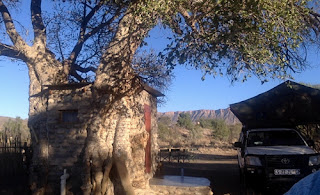My last post was made when we had
internet at a hotel in Swakopmund. Swakopmund is a beach city in
Namibia, and it is the popular resort town for the mid-December to
mid-January holidays. (That's summer here.) Many people from Namibia
and South Africa like to relax in Swakop (which is what most locals
call the city.) Swakop and nearby Walvis Bay are much cooler than the
rest of Namibia and have some of the few approachable beaches on
them.
We did not do much in Swakopmund. In
fact, we stayed an extra day there due to sickness. Syarra had a
fever, so we ended up doing two nights in a guest house and barely
leaving the room. But the guest house itself was lovely. And (as it was during Hanukkah) even in Namibia, Alrica made us latkes for the holiday.
 | |
| Namibian Latkes (similar to, but not entirely the same as American Latkes) |
From there we traveled southeast. We
first drove the road between Swakopmund and Walvis Bay which is
gorgeous. You have the ocean to your west and huge sand dunes to your
east. Partway between the two cities, we got stopped. Throughout
Namibia they have these road checkpoints where the police might pull
you over. We passed through several without eliciting any reaction
from the officials. But at this one, they had us pull over and asked
to see our passports, Alrica's driver's license, and the registration
for the car. All was in order and we were on our way.
We continued into the Namib Desert and
spent the night at the Tsauchab River Camp. This has got to be one of
the most interesting and unique campgrounds I have ever seen. First,
every site you can pitch your tent at is private and separated from
the other sites. Each has its own ablution facility. Ours was built
with a wild fig tree as part of the structure. And it was producing
wild figs.
 | |
| Fig Tree Ablution Facility |
The owners of the Tsauchab River Camp,
Johan and Nicky Steyn, have really done a lot with their land. There
are many hiking trails, some of them going for miles (or kilometres.)
Johan is an artist who makes sculptures, large and small, out of old
pieces of metal that once had another purpose in life. So the
campground is replete with little people, planes, vehicles, and
animals.
But for me, my favorite part of that
site was after the sun went down. We were far, far away from any
city, town, or source of light. It was dark. And there were so many
stars!
As a young boy I remember every once in
a while going out into the country in Iowa and seeing a truly black
sky with lots and lots of stars. I had forgotten how impressive the
sky really is. And we had done it just right, as this was the night
of the new moon.
We were staggered. As an example, we
saw Orion. Yes, you can see him in both the southern and northern
hemisphere because he is near the ecliptic. And I see Orion back at
home too. But here, you could not only see Orion but within him are
thousands, maybe millions of tiny, dim stars that you just cannot see
when you are near light pollution.
We saw Sirius, super bright and seeming
to change colors. And Alrica, looking with her naked eyes said “I
think that's really two stars.” And we looked it up and she's
right! Though the source we were reading said “Sirius is a binary
star, but one can't see both stars with the naked eye.” Apparently,
whoever wrote that doesn't have my wife's visual acuity.
We could make out the Andromeda Galaxy,
and using binoculars, you could even see it was a spiral galaxy.
But what was very exciting to me was to
see so many constellations that we cannot see in the northern
hemisphere. There is the Southern Cross, the False Cross, Mensa, and
Centauri. We also got to see the Greater and Lesser Magellanic
Clouds.
To be honest, that night, we could not
see the Southern Cross as it was below the horizon. And we also could
only see a few of the stars in Centauri, because many were below the
horizon. But a couple days later we got up super early (you will have
to read a different blog post to learn why) and we did see the the
Southern Cross. Plus, we could see Alpha Centauri, the second nearest
star to Earth!
That beautifully black night with its
millions of stars is one of my favorite moments in Namibia. Of
course, I have others, but that was a spectacle that was a true treat
in today's well-lit world. You should all find a nice dark place to
see the night sky. I think you will feel the same awe.
No comments:
Post a Comment